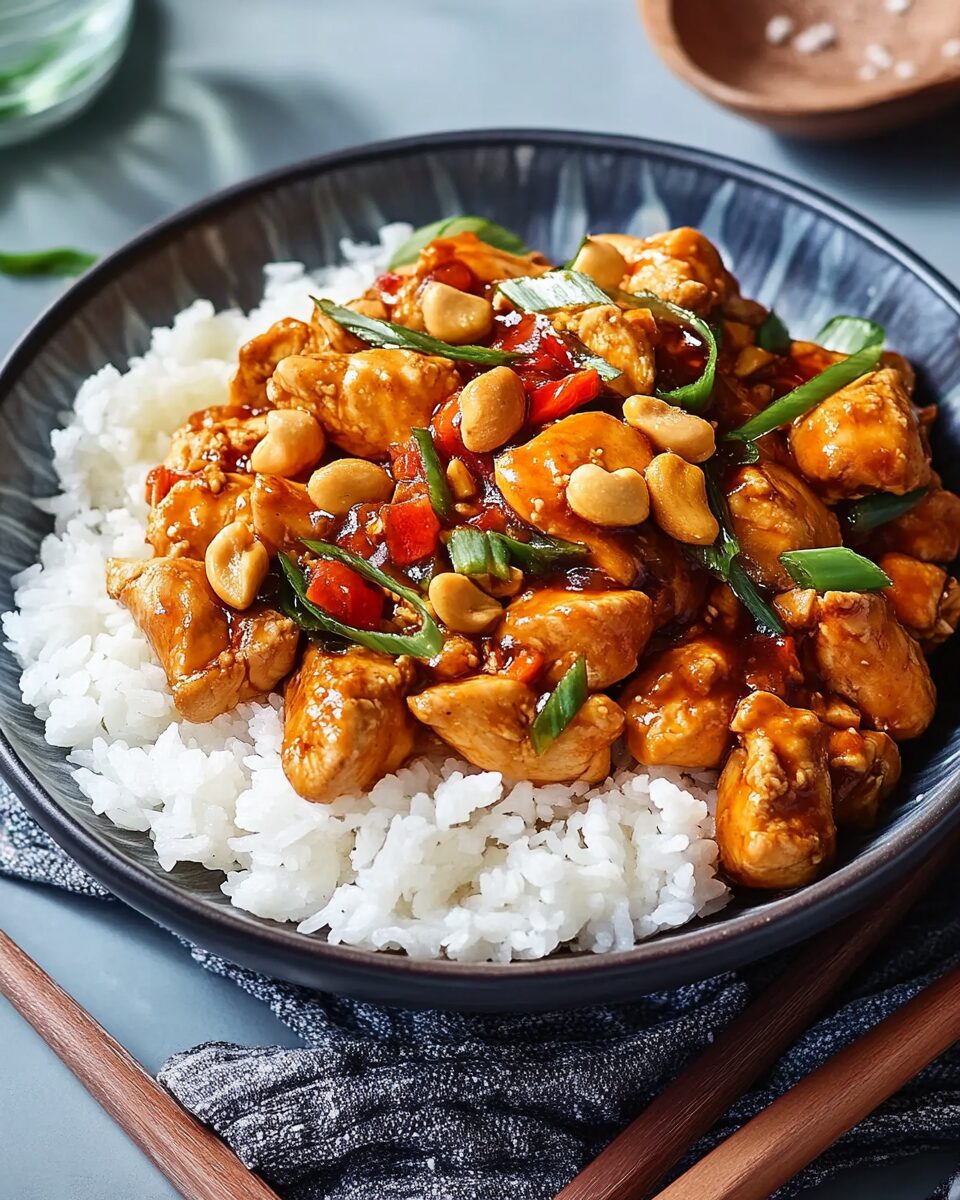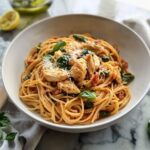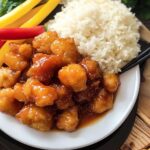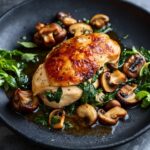Kung Pao Chicken is a popular and flavorful dish from Chinese cuisine, known for its savory, slightly spicy, and tangy sauce combined with tender chicken and crunchy peanuts. Often served with steamed rice, this dish strikes the perfect balance between protein, spice, and texture. Originating from the Sichuan region of China, Kung Pao Chicken has become a staple in Chinese-American restaurants and homes around the world. With its vibrant flavors and easy-to-follow preparation, it’s a favorite choice for those looking for a quick yet delicious meal. Whether you’re craving Chinese takeout or want to recreate this restaurant-quality dish at home, Kung Pao Chicken is the perfect option.
Full Recipe:
Ingredients
- 1 lb boneless, skinless chicken breasts, cut into bite-sized cubes
- 2 tablespoons soy sauce
- 1 tablespoon rice vinegar
- 1 tablespoon hoisin sauce
- 1 tablespoon chili paste with garlic
- 1/2 teaspoon sugar
- 1 tablespoon vegetable oil
- 1/2 cup unsalted dry roasted peanuts
- 3 dried red chilies
- 2 cloves garlic, minced
- 1/2 inch piece of ginger, minced
- 1 small onion, chopped
- 1 bell pepper, chopped
- 1 tablespoon cornstarch
- 2 tablespoons water
- Salt to taste
Directions
- In a small bowl, combine soy sauce, rice vinegar, hoisin sauce, chili paste with garlic, and sugar. Set aside.
- In a separate bowl, dissolve cornstarch in water and set aside.
- Heat vegetable oil in a large skillet or wok over medium-high heat. Add the dried red chilies and stir-fry for 30 seconds until fragrant.
- Add the chicken cubes to the skillet and cook, stirring occasionally, until browned and cooked through, about 5-7 minutes.
- Add the garlic, ginger, onion, and bell pepper to the skillet, and cook for another 2-3 minutes until the vegetables begin to soften.
- Stir in the prepared sauce mixture and bring it to a simmer. Add the cornstarch slurry and cook until the sauce thickens, about 1-2 minutes.
- Toss in the peanuts and cook for another minute until they are heated through.
- Serve the Kung Pao Chicken hot, garnished with green onions if desired, and enjoy!
Nutrients
- Calories: 330 kcal per serving
- Fat: 20g
- Saturated Fat: 3g
- Cholesterol: 70mg
- Sodium: 900mg
- Carbohydrates: 18g
- Fiber: 3g
- Sugar: 6g
- Protein: 25g
The History and Origins of Kung Pao Chicken
Kung Pao Chicken, or 宫保鸡丁 (gōng bǎo jī dīng), has deep roots in Chinese history and has evolved into a dish with a rich, storied past. Its origin can be traced back to the Qing Dynasty (1644–1912) in the Sichuan region of China. The dish is named after Ding Baozhen, a Qing official who served as the governor of Sichuan. Ding Baozhen was known for his fondness for cooking, and it is said that the dish was created in his honor, with “Kung Pao” (宫保) meaning “palace guardian” or “official.”
The traditional version of the dish includes stir-fried chicken, peanuts, and chili peppers, cooked in a spicy, sweet, and tangy sauce. The classic preparation uses Sichuan peppercorns to give the dish its signature numbing spiciness, which is a hallmark of Sichuan cuisine. The numbing sensation from the peppercorns, combined with the heat from the dried red chilies, creates a unique flavor profile that differentiates Kung Pao Chicken from other stir-fried chicken dishes.
Though the origins of Kung Pao Chicken are firmly rooted in Sichuan cooking, the dish has undergone significant transformation as it spread to other regions of China and, eventually, around the world. In Western versions of the dish, the use of Sichuan peppercorns is often omitted, and the flavors tend to be more focused on sweetness and saltiness. Kung Pao Chicken became a popular takeout dish in Chinese-American restaurants in the mid-20th century, where it adapted to local tastes and preferences. This dish is now enjoyed by people worldwide, and while some variations exist, the core ingredients and principles of the recipe remain consistent.
Key Ingredients and Their Role in Kung Pao Chicken
Kung Pao Chicken relies on a few key ingredients that come together to create its bold and delicious flavors. Each component of the dish adds something special to the overall taste, making it an irresistible meal.
-
Chicken: The base of the dish is boneless, skinless chicken breasts or thighs, which are cut into bite-sized cubes. Chicken is a great protein choice for Kung Pao, as it absorbs the flavors of the sauce while maintaining its juicy, tender texture when cooked properly. The chicken is often stir-fried to a golden brown, giving it a satisfying, slightly crispy exterior.
-
Peanuts: Dry-roasted peanuts are a signature element of Kung Pao Chicken. They provide a satisfying crunch that contrasts beautifully with the tender chicken and soft vegetables. The peanuts are lightly fried to bring out their nutty flavor, and they also add richness to the dish. They are crucial for the texture and balance of the dish.
-
Chili Peppers: The dried red chili peppers used in Kung Pao Chicken give the dish its signature spicy kick. The heat from the chilies is balanced by the sweetness and saltiness of the sauce. While the chilies bring the heat, they are not meant to be eaten whole but rather to impart flavor and spice to the dish.
-
Aromatic Vegetables: Typically, onions and bell peppers are used in Kung Pao Chicken. These vegetables not only provide color but also add sweetness and crunch that complement the spiciness of the dish. The onions give the dish a slight tang, while the bell peppers bring freshness and balance to the otherwise rich and spicy flavors.
-
Sauce: The sauce is the heart of Kung Pao Chicken, and it is what ties all the ingredients together. It’s typically made with a combination of soy sauce, rice vinegar, hoisin sauce, sugar, and sometimes chili paste or chili garlic sauce. The balance of salty, sweet, and tangy flavors is key to achieving the perfect sauce. The sauce is slightly thickened with cornstarch, which helps it coat the chicken and vegetables evenly.
-
Aromatics: Garlic and ginger are often used in the sauce or stir-fry base, providing fragrance and a deeper layer of flavor. Their fresh, pungent qualities complement the sweetness of the sauce and the heat from the chilies.
-
Sichuan Peppercorns (Optional): While not always included in Western variations of Kung Pao Chicken, Sichuan peppercorns are an essential ingredient in the traditional recipe. These peppercorns impart a distinctive “numbing” sensation on the tongue, which is an iconic characteristic of Sichuan cuisine. The numbing sensation helps balance the heat of the chilies and enhances the overall flavor experience.
Cooking Tips for Perfect Kung Pao Chicken
Making restaurant-quality Kung Pao Chicken at home can be simple with a few key tips and techniques. Here are some suggestions to ensure that your dish turns out perfect every time:
-
Use High-Heat Cooking: Kung Pao Chicken is traditionally stir-fried over high heat. Using a wok or large skillet ensures that the chicken and vegetables cook quickly and evenly, giving the dish the perfect texture. Be sure to preheat your pan before adding oil to avoid steaming the chicken.
-
Cook the Chicken in Batches: To ensure the chicken cooks properly and gets a golden-brown crust, it’s best to cook the chicken in small batches. Overcrowding the pan can lead to uneven cooking, so it’s better to take your time and cook the chicken in portions.
-
Balance the Flavors: Kung Pao Chicken is all about balancing heat, sweetness, and savoriness. Adjust the amount of soy sauce, hoisin sauce, and chili paste according to your taste preferences. If you prefer a sweeter dish, add more sugar or hoisin sauce. If you prefer more heat, increase the amount of chili paste or dried chilies.
-
Toast the Peanuts: To bring out the best flavor in the peanuts, lightly toast them in the pan before adding them to the dish. This will enhance their nutty taste and add an extra layer of crunch to the final dish.
-
Don’t Overcook the Vegetables: The vegetables in Kung Pao Chicken should still be crisp and vibrant, so be careful not to overcook them. Add them towards the end of cooking and stir-fry them just until they begin to soften.
Variations and Customizations
While Kung Pao Chicken is traditionally made with chicken, there are several variations of the dish that cater to different dietary preferences. You can easily swap out the chicken for tofu, shrimp, or even beef to create different versions of the dish. Each variation brings its own flavor and texture to the dish, making Kung Pao a versatile recipe that can be tailored to your liking.
For a vegetarian or vegan version, substitute the chicken with tofu and use vegetable broth instead of chicken broth in the sauce. The tofu should be pressed to remove excess moisture, then cubed and stir-fried until golden brown. The rest of the ingredients remain the same, providing a satisfying and hearty alternative for those avoiding meat.
You can also adjust the level of spiciness to suit your preferences. If you enjoy a more mild dish, reduce the number of dried chilies or use a mild chili paste. For those who love a spicy kick, increase the amount of chili paste and Sichuan peppercorns for extra heat.
Conclusion
Kung Pao Chicken is a delicious, flavorful dish that exemplifies the best of Chinese-American cuisine. With its savory sauce, tender chicken, crispy peanuts, and vibrant vegetables, it’s a dish that is as satisfying to eat as it is easy to prepare. Whether you’re cooking it for a quick weeknight dinner or serving it to guests for a special occasion, Kung Pao Chicken is sure to please with its rich flavors and satisfying textures.






